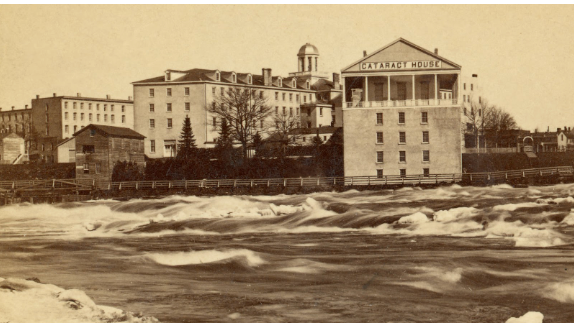
Four Paths to Freedom
Far from their intended use, a staircase, rowboat, hotel, and bridge became part of the Underground Railroad in Niagara Falls
Looking at old photographs of Niagara Falls, New York, it might not seem like a staircase, rowboat, luxury hotel, and bridge would have much in common other than being spaces that people used while in transit from one place to another. It might not seem like these spaces would have held many secrets, let alone shared histories of brave and dangerous escapes, silent footfalls and whispers in the night. But that is exactly the case for the Whitney staircase and ferry service, Cataract House, and International Suspension Bridge. In the nineteenth century, these places were powerful sites of Underground Railroad activism and resistance.
General Parkhurst Whitney was one of the first European-American settlers in Niagara Falls. In 1818, he built a staircase at the base of the American Falls to replace an 80-foot-long ladder that had been destroyed there during the War of 1812. In 1820, Whitney opened a ferry service near the stairs where small rowboats transported people and goods across the Niagara River.
Whitney also owned and operated the world-famous Cataract House from 1831-1846. The Cataract House was one of the most luxurious hotels in Niagara Falls. While not a public abolitionist, Whitney began hiring African Americans as early as the 1840s. The Cataract House was poised on the banks of the Niagara River--quite close to Whitney’s staircase and ferry service. Many African Americans escaped slavery using these conveyances.
How did they do it? Well, the waiters at the Cataract House were well aware that slaveholding families from the South visited the hotel and brought enslaved valets and ladies’ maids. In response, the waiters organized a resistance movement that helped enslaved people escape to freedom in Canada. Despite various dangers, including the 1850 passage of the Fugitive Slave Act, the waiters helped freedom seekers slip away from the hotel and make their way down the ferry staircase and toward the waiting rowboats. Headwaiter John Morrison regularly ferried freedom seekers across the river himself.
According to the Niagara Falls Underground Railroad Heritage Center, “Many African Americans escaped to freedom on the ferry. The dramatic escape of ‘Martha’ and her husband, as they were chased down [the] steep staircase to the Ferry Landing by a would-be band of bounty hunters, is among the most notable. Accounts also exist to document Nancy Berry’s (much less dramatic) ferry ride, as well as Patrick Sneed’s unsuccessful attempt to cross the river at this location.”
The ferry service eventually evolved into the famous
Maid of the Mist steamboat tours. When not in use, the steamboat docked just below the International Suspension Bridge. Built in 1848 and expanded in 1855, many freedom seekers, often aided by Harriet Tubman, crossed this bridge into Canada.
For more stories about the Underground Railroad in Niagara Falls visit niagarafallsundergroundrailroad.org and discoverniagara.org
Niagara Falls Heritage Area

